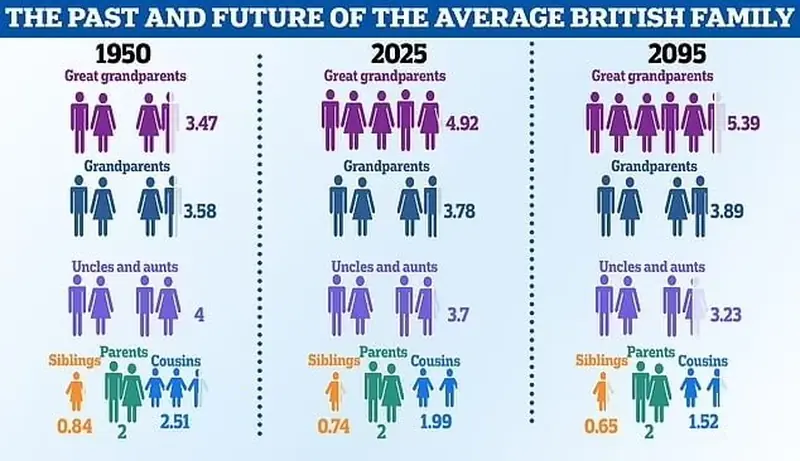
According to scientists, family dinners in the future will be smaller and significantly quieter. The average person will have more grandparents but fewer cousins. This is the conclusion drawn by researchers from the Max Planck Institute for Demographic Research in Germany.
By analyzing demographic trends, they noted that families are becoming increasingly smaller. In 1950, the average 65-year-old woman had 41 living relatives, but by 2095, that number is expected to drop to just 25. The structure of families will also change. Grandparents, great-grandparents, and great-great-grandparents will live longer, while fewer children will be born into families.
What the researchers discovered
Scientists have long been concerned that declining birth rates and increasing life expectancy could lead to an aging population. However, until now, researchers had not examined how this trend would affect family structures, noted lead author Diego Alburess-Gutierrez.
He and his colleagues analyzed historical and projected data from the UN’s World Population Prospects report for 2022. To understand how families might change, the team focused on the hypothetical figure of an average 65-year-old woman.
The analysis showed that her family size will steadily decrease worldwide over the next 70 years. This reduction will be most pronounced in Latin America and the Caribbean. In these regions, the family of a 65-year-old woman is expected to shrink from 56 living relatives (as it was in 1950) to just 18.3 by 2095—a decrease of 67 percent.
Meanwhile, family sizes in Europe and North America, where birth rates are already very low, will remain virtually unchanged. The gap in family sizes between different countries is likely to narrow as we approach the end of the century, according to the Daily Mail.
In 1950, the difference in the average family size of a 65-year-old woman in Latin America and the Caribbean compared to Europe and North America was 31 relatives. However, by 2095, researchers predict that the largest gap between families in any two regions will be just 20 living relatives.

These trends are also evident at the country level
In 1950, the average Zimbabwean woman approaching 65 could expect to have 82 living relatives. By 2095, her counterpart will have only 24.1. Meanwhile, the average 65-year-old woman in Italy, where families are the smallest in the world, will see her number of living relatives drop from 18 to 12.7.
However, families will not only change in size but also in their “configuration of relatives,” researchers noted. The average family of the future will consist of significantly fewer cousins, nieces, nephews, and grandchildren. However, the number of grandmothers, grandfathers, great-grandparents, and great-grandmothers is expected to rise sharply.
Scientists say this shift is driven by a balance of four factors: decreasing child mortality, increasing life expectancy, declining birth rates, and delayed childbirth.
While decreasing child mortality will increase the number of siblings, cousins, and other relatives in families, lower and later birth rates will counteract this trend.
Similarly, increasing life expectancy will raise the likelihood that people will live long enough to become grandparents and great-grandparents. However, low and delayed birth rates will reduce the chances that anyone will live long enough to become a grandparent.
According to researchers, these predictions have troubling implications for future healthcare. For any 65-year-old, the availability of relatives who can provide care and support will be significantly lower in 2095.
“As the age gap between people and their relatives increases, families will not only be smaller but also older,” concluded Diego Alburess-Gutierrez.
The findings of the study were published in the journal PNAS.
